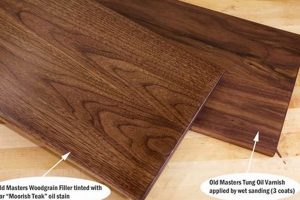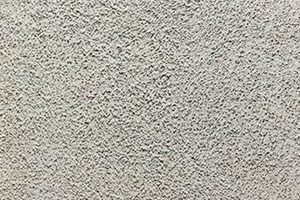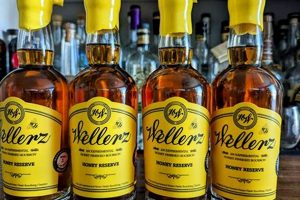Wall and ceiling surfaces crafted from gypsum board, commonly known as sheetrock, frequently receive applied coatings to enhance aesthetics and mask imperfections. These coatings provide a variety of visual effects, ranging from subtle smoothness to pronounced patterns. An example is the application of a “knockdown” style, which leaves flattened, textured mounds on the surface.
The implementation of these surface treatments offers numerous advantages. They contribute to the overall design scheme of a space, allowing for customization and personalization. Furthermore, they can effectively conceal minor flaws, such as seams or nail holes, thereby improving the visual appeal of the finished wall or ceiling. Historically, these techniques have evolved alongside interior design trends, reflecting changing tastes and technological advancements in application methods and materials.
The subsequent sections will delve into specific types of surface treatments, application techniques, considerations for selecting the appropriate method, and best practices for achieving a professional-quality outcome.
Considerations for Achieving Optimal Results
The successful application of coatings to gypsum board surfaces requires careful planning and execution. These tips address key aspects of the process to ensure a professional and lasting finish.
Tip 1: Surface Preparation is Paramount: Prior to any application, the gypsum board must be clean, dry, and free of dust or debris. All seams should be properly taped and mudded, creating a smooth and even substrate. Failure to adequately prepare the surface will compromise the final appearance and adhesion of the coating.
Tip 2: Primer Application is Essential: A quality primer serves as a bonding agent between the gypsum board and the chosen material. It also helps to equalize porosity, preventing uneven absorption of the subsequent coating. Select a primer specifically formulated for gypsum board surfaces.
Tip 3: Control Environmental Conditions: Temperature and humidity levels can significantly impact the drying and curing process. Avoid application in excessively humid or cold environments. Maintain consistent conditions within the recommended range specified by the product manufacturer.
Tip 4: Select the Appropriate Tooling: Different techniques require specific tools. Hopper guns are commonly used for spray-applied effects, while trowels and brushes are suitable for hand-applied methods. Experiment with various tools to achieve the desired texture and pattern.
Tip 5: Practice Application Techniques: Before applying the coating to the entire surface, practice on a test area. This allows for experimentation with different techniques and adjustments to achieve the desired aesthetic. Observe the drying characteristics of the coating in the practice area.
Tip 6: Maintain Consistent Application: Ensure uniform coverage across the entire surface. Avoid excessive build-up or thin spots, which can lead to an uneven appearance. Overlap passes slightly to create a seamless and consistent pattern.
Tip 7: Allow Adequate Drying Time: Adhere to the manufacturer’s recommended drying time before applying subsequent coats or paint. Rushing the drying process can result in cracking, peeling, or other defects. Ensure proper ventilation to facilitate drying.
Consistent surface preparation, proper primer selection, controlled environmental conditions, and careful application techniques are crucial for a high-quality, durable, and visually appealing surface. By adhering to these considerations, the longevity and aesthetic value of the treated surface will be maximized.
The following sections will further explore the specific types of patterns and materials available.
1. Aesthetic Preferences
Aesthetic preferences serve as the foundational determinant in selecting appropriate surface treatments for gypsum board. The desired visual outcome directly dictates the range of viable options, impacting the choice of materials, application techniques, and ultimately, the perceived quality of the finished space. A contemporary, minimalist design, for instance, typically necessitates smooth, level-five finishes or subtly textured surfaces, achieved through skim coating or light spray applications. Conversely, rustic or traditional aesthetics often embrace heavier, more pronounced textures, such as orange peel or knockdown, to introduce visual interest and depth.
The impact of aesthetic preferences extends beyond mere visual appeal. They influence the perceived value and marketability of a property. In high-end residential developments, smooth, flawlessly finished walls are often considered a sign of quality and attention to detail, attracting discerning buyers. Conversely, in more casual or budget-conscious settings, less refined surfaces may be deemed acceptable or even desirable. The careful alignment of surface treatments with the target audience and overall design intent is therefore crucial for achieving a successful and well-received project. Real-world examples include choosing a smooth finish in a modern art gallery to not distract from the artwork versus a textured finish in a themed restaurant to enhance the atmosphere.
Ultimately, understanding the interplay between aesthetic preferences and the available surface applications empowers informed decision-making. The challenge lies in translating abstract design concepts into concrete material choices and application methods, while considering budgetary constraints and practical limitations. A well-defined aesthetic vision, coupled with a thorough understanding of available options, facilitates the selection of surface treatments that not only enhance the visual appeal of a space but also contribute to its overall value and functionality.
2. Application methods
The method employed to apply surface treatments to gypsum board directly influences the resultant texture and overall aesthetic. Method selection necessitates careful consideration of the desired effect, scale of the project, and available skill set.
- Spray Application (Hopper Gun)
This method uses compressed air to propel coating material onto the gypsum board, creating textures such as orange peel, knockdown, or popcorn. Hopper guns offer efficient coverage for large areas and enable consistent texture, but require precise control of air pressure and material viscosity to avoid inconsistencies. Real-world applications include texturing ceilings in residential developments. Improper technique results in an uneven distribution of materials.
- Trowel Application
Trowel applications involve manually applying and manipulating coating material with a trowel to create textures like swirl or skip-trowel. This method offers greater control over the texture’s depth and pattern but demands significant skill and labor. Examples include creating unique wall textures in custom homes. Inadequate troweling technique produces visible imperfections.
- Roll-On Application
Roll-on techniques involve using textured rollers to transfer coating material onto the gypsum board. This method provides a relatively simple means of achieving uniform textures, suitable for smaller projects or DIY applications. Examples include creating a subtle stipple texture on walls. Incorrect roller selection results in an undesirable texture profile.
- Hand-Applied Techniques (Brushing, Sponging)
Hand-applied methods use brushes or sponges to create custom textures. These methods offer the most artistic freedom but require extensive skill and are typically reserved for accent walls or decorative elements. Examples include creating a faux finish with layered glazes. A lack of artistic skill results in a haphazard and unprofessional look.
The selection of the appropriate application method is intrinsically linked to the desired outcome. Spray application facilitates efficiency and uniformity, while trowel and hand-applied techniques offer greater control and customization. A thorough understanding of each method’s capabilities and limitations is crucial for achieving the intended texture and overall aesthetic of the gypsum board surface.
3. Cost Implications
The application of surface treatments to gypsum board introduces varied cost implications directly linked to the materials employed and the labor required for installation. The selection of a particular finish necessitates a comprehensive understanding of these costs to ensure projects remain within budgetary constraints. For example, a smooth, level-five finish demands extensive surface preparation and multiple coats of joint compound, escalating both material and labor expenses significantly compared to a simple orange peel finish. The complexity of the chosen texture has a direct cause-and-effect relationship with project expenditures. Furthermore, specialized equipment such as texture sprayers or the need for highly skilled applicators for techniques like Venetian plaster contributes substantially to overall project costs. It is crucial, therefore, to regard cost implications as an integral component in the decision-making process regarding finishes.
Real-life examples illustrate the practical significance of understanding these costs. A large-scale residential development opting for a knockdown texture over a smooth finish can realize considerable savings due to reduced material usage and labor hours. Conversely, a high-end commercial space may justify the higher cost of a specialized finish to project a premium aesthetic, thereby influencing its market positioning. The decision must balance visual appeal with budgetary realities. Additional cost factors include the lifespan of the finish and potential maintenance expenses. Some textures are more susceptible to damage and require more frequent repairs or reapplication, impacting long-term costs. A comprehensive cost analysis should also consider the geographical location of the project, as labor rates and material availability can vary significantly, thereby impacting overall project expenses.
In summary, navigating the cost implications associated with finishes necessitates a holistic approach, encompassing material costs, labor expenses, equipment requirements, and long-term maintenance considerations. Effectively balancing these factors ensures projects remain within budget while achieving the desired aesthetic and functional goals. The challenge lies in accurately estimating the total cost of each option, factoring in potential unforeseen expenses, and making informed decisions that align with the project’s overall objectives and available resources.
4. Durability requirements
The selection of surface treatments for gypsum board necessitates a careful evaluation of durability requirements. The anticipated level of wear and tear, potential for impact, and exposure to moisture significantly influence the choice of materials and application methods. Insufficient consideration of durability can lead to premature failure of the finish, resulting in costly repairs and aesthetic degradation.
- Impact Resistance
Areas subject to frequent impact, such as hallways or children’s rooms, demand finishes with high impact resistance. This can be achieved through the selection of more robust coating materials or the application of reinforcing additives. For instance, epoxy-based coatings provide superior impact resistance compared to standard latex paint. Failure to address impact resistance results in dents, chips, and cracks in the finish. Real-world examples include reinforcing the finish on walls in school hallways to withstand student traffic.
- Abrasion Resistance
Surfaces prone to abrasion, such as those near doorways or furniture, require finishes that resist scratching and scuffing. Selecting coatings with a higher sheen level, such as semi-gloss or gloss, enhances abrasion resistance. Additionally, incorporating aggregate materials into the finish can provide a protective layer. In retail environments, walls near displays benefit from abrasion-resistant finishes. Without this, surfaces exhibit unsightly wear patterns.
- Moisture Resistance
Areas with high humidity or potential water exposure, such as bathrooms and kitchens, necessitate finishes that resist moisture penetration. Applying moisture-resistant primers and topcoats is crucial. Some textured finishes, like those incorporating lime plaster, naturally resist mold and mildew growth. Ignoring moisture resistance leads to blistering, peeling, and potential mold growth. An example is using specialized paint in a shower area to prevent moisture damage.
- Cleanability
Finishes in high-traffic areas or spaces prone to dirt and grime require easy cleanability. Smooth finishes are generally easier to clean than heavily textured ones. Selecting coatings with a washable or scrubbable formulation allows for the removal of dirt and stains without damaging the finish. Walls in hospitals benefit from easily cleanable finishes to maintain hygiene. Difficulty in cleaning can result in permanent staining and aesthetic degradation.
The interplay between durability requirements and the choice of surface treatments is critical for ensuring the longevity and aesthetic appeal of gypsum board surfaces. By carefully considering the anticipated wear and tear, exposure to moisture, and cleaning demands, informed decisions can be made regarding the selection of materials and application methods. This proactive approach minimizes the risk of premature failure, reduces maintenance costs, and maintains the desired aesthetic for an extended period.
5. Maintenance Needs
Surface treatments applied to gypsum board, while enhancing aesthetics, inherently introduce specific maintenance needs directly correlated with the chosen texture and material. The complexity of the texture significantly impacts the ease and frequency of cleaning, repair, and overall upkeep. Heavily textured surfaces, for example, tend to accumulate dust and debris within the crevices, requiring more rigorous and frequent cleaning compared to smooth surfaces. This cause-and-effect relationship underscores the importance of considering long-term maintenance implications during the selection process. Ignoring these needs can result in diminished aesthetic appeal, premature degradation, and ultimately, increased life-cycle costs. For instance, popcorn ceilings, once a popular choice, are now often removed due to their difficulty in cleaning and propensity to collect dust and cobwebs. In contrast, smooth walls can be easily wiped down, requiring less intensive maintenance efforts.
Understanding the connection between texture and maintenance needs has practical significance in various real-world applications. In commercial settings, such as restaurants or hospitals, where hygiene is paramount, smooth, easily cleanable finishes are often preferred to minimize the accumulation of dirt and bacteria. Similarly, in residential environments with children or pets, durable and easily washable finishes are essential to withstand daily wear and tear. The choice of material also plays a crucial role. Certain paints and coatings are more resistant to staining and abrasion, simplifying cleaning and prolonging the life of the finish. Furthermore, some textures are more susceptible to damage from impact or moisture, necessitating more frequent repairs or reapplication. An example is the use of scrubbable paint in bathrooms to resist moisture damage. Regular cleaning and timely repairs are essential to maintaining the visual appeal and structural integrity of the surface treatment.
In summary, assessing maintenance needs is an indispensable component of selecting surface treatments for gypsum board. The interplay between texture, material, and the anticipated level of wear and tear dictates the frequency and intensity of maintenance required. The challenge lies in balancing aesthetic desires with practical considerations to ensure long-term cost-effectiveness and sustained visual appeal. A proactive approach, involving careful planning and informed material selection, minimizes the need for extensive maintenance interventions and preserves the value of the treated surface over time.
Frequently Asked Questions
The following section addresses common inquiries regarding surface treatments for gypsum board. These answers aim to provide clarity and guidance for informed decision-making.
Question 1: What constitutes the primary purpose of surface treatments applied to gypsum board?
The primary purpose is multifaceted, encompassing aesthetic enhancement, concealment of imperfections, and creation of a durable, uniform surface suitable for painting or other decorative finishes.
Question 2: How does one determine the appropriate surface treatment for a given application?
Selection depends on factors such as desired aesthetic, budget constraints, anticipated level of wear and tear, and environmental conditions. Careful consideration of these elements is crucial.
Question 3: Are certain surface treatments inherently more durable than others?
Yes. Epoxy-based coatings, for example, generally exhibit greater impact and abrasion resistance compared to standard latex paints. Specific durability requirements should guide material selection.
Question 4: What precautions should be taken during the application of surface treatments to minimize potential issues?
Thorough surface preparation, including cleaning, sanding, and priming, is essential. Adherence to the manufacturer’s recommendations regarding application techniques and drying times is also critical.
Question 5: Can surface treatments be applied over existing paint or wallpaper?
It is generally advisable to remove existing paint or wallpaper prior to applying surface treatments to ensure proper adhesion and a uniform finish. Exceptions may exist depending on the specific materials involved.
Question 6: What are the potential long-term maintenance requirements associated with different surface treatments?
Maintenance needs vary depending on the texture and material. Heavily textured surfaces tend to accumulate dust and debris more readily, requiring more frequent cleaning. Regular inspection and timely repairs are essential for preserving the integrity of the finish.
Proper planning and execution are paramount for achieving optimal results when applying surface treatments to gypsum board. Consideration of both aesthetic and practical factors is crucial for long-term satisfaction.
The subsequent sections will explore best practices for achieving a professional-quality finish.
Conclusion
This discussion has provided an overview of surface applications on gypsum board, addressing the diverse range of options available, from material selection to application techniques. It has emphasized the importance of balancing aesthetic preferences with practical considerations such as cost, durability, and maintenance. A comprehensive understanding of these factors is essential for informed decision-making and successful project outcomes.
The judicious selection and application of surface treatments can significantly enhance the value and longevity of gypsum board surfaces. Continued research and development in this field promise further advancements in materials and techniques, providing even greater opportunities for customization and performance. Proper execution remains the key to achieving a professional and lasting result.







